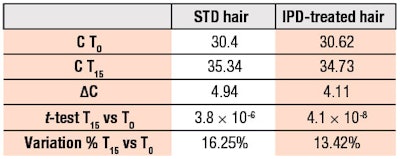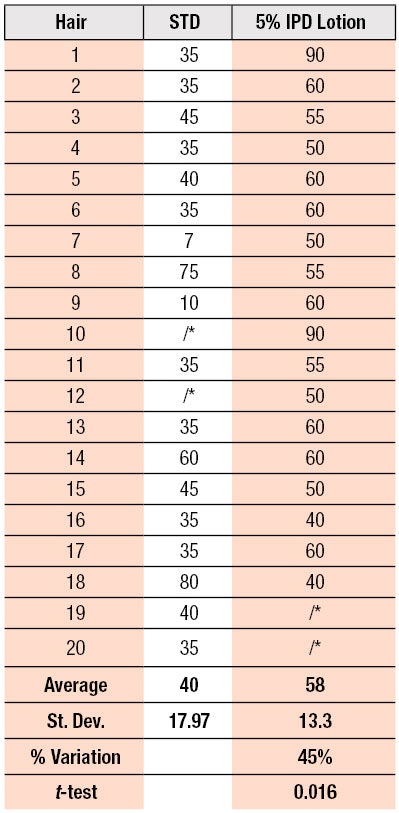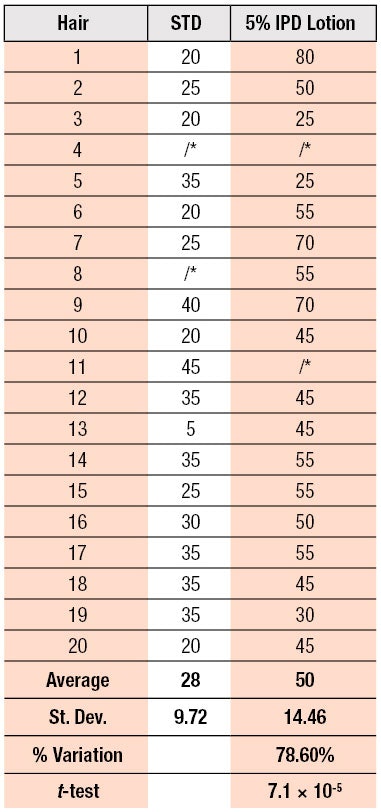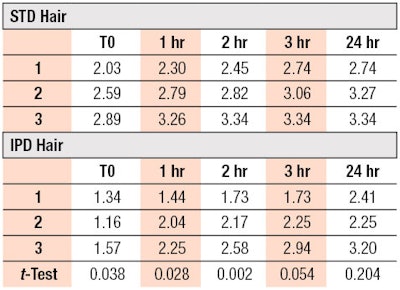
Isopentyldiol (IPD) is a branched chain bi-alcohol with five carbon atoms (3-methyl-1,3-butanediol; see Figure 1) with a unique molecular structure that makes it versatile—i.e., capable of interacting with both hydrophilic and lipophilic substances. Thanks to its solvent, coupling and humectant properties, along with its positive influence on sensory performance, IPDa is widely used in many types of skin care and cosmetic recipes. More recently, it has been tested in hair care, where it demonstrates additional interesting benefits, as will be shown.
In a previous study, the reparative effects of IPD on damaged hair were investigated. After treatment with an aqueous solution of 5% IPD and 5% sorbitol, the smoothness of damaged hair increased, compared with IPD alone or with hydrolyzed proteins or other polyols in place of sorbitol.1 Indeed, the appearance of damaged hair fibers by microscopic analysis improved thanks to the synergistic effect of IPD with sorbitol.2
Tested in combination with sodium laureth sulfate (SLES), IPD also increased foam height and stability, proportionally to its concentration. In mild surfactant systems, the best results were observed with 2% IPD.3 Moreover, the after-feel of cleansing formulas containing IPD was reported to be less dry and more emollient than reference products without it. Also, in cleansing formulas containing an oil phase, IPD improved hair shine and provided ease of combing and a soft feel on hair.4
Considering the reported benefits, the present study sought to further investigate the cosmetic applications of IPD in hair. Three main areas were of particular interest: the influence of IPD on dyed hair in terms of color retention; its ability to improve the resistance of hair to breakage; and its anti-frizz effect.5
Materials and Methods: Color Retention
For consumers who dye their hair, one issue of great concern is color fade after repeated washing, especially for red shades. The aim of this test was to assess the effects of IPD on color retention after 15 wash cycles by comparing standard dyed hair strands with IPD-treated dyed strands.
Hair samples: The hair strands used for color-retention tests were straight, bleached Italian blonde hair. The samples were divided into four test bundles, weighing approximately 4.5 g each.
Color measurements: A portable, dual channel reflecting colorimeterb was used to capture color intensity readings. For each bundle, five measurements were taken at five different positions. Each result was calculated as the average of three detections (automatically given by the instrument). The detection system used was based on CIE-Lab parameters and corresponded to the Cartesian coordinates L*, a* and b*, where:
L* refers to the gray axis. L* values range from 0 to 100, where 0 corresponds to black and 100, to white; and
Values a* and b* each refer to a two-color axis. Value a* represents the red-green color axis and b*, the yellow-blue axis. Both parameters range from -60 (100% green for a* and blue for b*) to +60 (100% red for a* and yellow for b*).
Color Retention Protocol
Preparation: All four hair bundles were first cleansed with a standard shampoo (see Formula 1) then rinsed with tap water to equalize the surface of the hair. Strands were then blown dry and treated with a red dyeing preparation activated by an oxidizing cream (hydrogen peroxide @ 20 vol.) in a ratio of 1:1.5, which remained on hair for 30 min. Two test bundles were dyed using a formula including 5% IPD, while the other two bundles were treated with a standard (STD) dye treatment, without IPD and with 5% demineralized water in its place. The IPD-containing shampoo was used for successive treatments in order to sustain and enhance the IPD color protective properties inside the hair. After dyeing, all strands were rinsed with tap water, then blown dry. The color performance at time 0 (after the first application) was also measured.
The ability of IPD to improve shine, feel and combability in hair have been reported, thus the authors studied its hair benefits further.
Washing cycles: Successively, the strands were repeatedly washed and dried for 15 total cycles, where the same two bundles (STD) were cleansed with the shampoo in Formula 1, and the other two bundles were cleansed with the same shampoo except containing the added 2.5% IPD (in place of water).
The following parameters were evaluated to assess color retention performance after repeated washing:
L* = the covering effectiveness of the dye;
C = saturation, calculated as [(a)2 + (b)2]1/2, which describes the intensity of color/brightness;
L* variation after 15 washes, in comparison with T0 (ΔL): L* increase corresponds to a reduction in the covering effect of the color;
C variation after 15 washes, in comparison with T0 ( ΔC): A significant increase of the C parameter is related to a more intense color, while its reduction corresponds to a more opaque color; and
ΔE, total color variation, calculated as = [(ΔL)2+(Δa)2+(Δb)2]1/2: the higher the variation in absolute value, the higher the difference between initial and final color of the strands.6
Results: Color Retention
As noted, five measurements were taken for each bundle in five different positions for a total of 10 values for STD hair and 10 values for IPD-treated hair. These values are shown in Table 1, Table 2, Table 3 and Table 4. The variations ΔL, Δa and Δb are calculated as the difference between the average values obtained after 15 washes and the T=0 values within each group of strands. The values of L*, ΔL, C, ΔC and ΔE are reported in Table 5, Table 6 and Table 7; note that the t-test was used and shows the statistical significance of the % variation.
The absolute color variation (ΔE) was significantly lower for the hair cleansed with shampoo containing IPD. The % variations of parameters L* and C are also lower for the strands treated with IPD. This means the expression of color and brightness after repeated wash and rinse cycles was improved by the inclusion of IPD, demonstrating it increased the dye retention and protected the hair from color fade.
The absolute color variation and expression of color and brightness were significantly improved for hair cleansed using IPD.
Materials and Methods: Hair Strength
It is known the tensile properties of hair can be improved through the application of humectants, which promote water retention, increasing the elasticity and lowering the brittleness of hair. The technical definition of hair strength is a measure of its resistance to a force, which can be evaluated in different ways. For the present work, it was measured by applying a progressively increased weight and tracking the load required to break a single hair fiber under constant traction. This effort was measured in grams.
Set-up: To carry out this test, a metallic stand with a cast iron bar was used. Pliers with a clamp were positioned on the head of the bar. The hair was fixed on one side to the pliers and hung to the other side with a Hoffmann clamp. Increasing amounts of standard weights (1 g and 5 g of an E2 certified class) were hung on the Hoffmann clamp (see Figure 2).
Strength tests: The first set of tests was carried out using straight, depigmented blonde Italian hair, 16 cm in length, divided into two test bundles weighing around 4.5 g each. These were cleansed with the standard shampoo (see Formula 1); again, to equalize the hair. They were then blown dry, and one sample was sprayed homogeneously with a solution including: water 75%, alcohol denat. 20% and IPD 5%.
After drying, 20 single hairs were randomly taken from the bundle to evaluate the breaking load; 20 hairs also were randomly taken from the STD bundle, for comparison. A second set of tests was carried out in a similar way but on the same hair colored using the red dye preparation, described above.
Results: Blonde Hair
In Table 8 and Figure 3, the breaking load values of the STD hair are compared with those of the 5% IPD-treated hair. For statistical accuracy, the higher and lower values in each set were discarded. Results indicated the treatment of hair with a solution containing 5% IPD increased its strength by improving resistance to breakage by 45%, in comparison with the standard hair.
In Table 9 and Figure 4, the breaking load values of the STD red hair are compared with those of 5% IPD-treated red-dyed hair. Once again, for statistical accuracy, the higher and lower values in each set were discarded. Even in the case of red-dyed hair, treatment with a solution containing 5% IPD increased hair strength, improving hair’s resistance to breakage by 78.6%. Thus, IPD was found to strengthen red dye-treated hair—which is generally more stressed and brittle than non-treated hair—by increasing the breaking load considerably; to a level higher than that of uncolored hair.
A high degree of fiber alignment makes hair smooth, shiny and practically free from frizz.
Materials and Methods: Anti-frizz Effect
A high degree of fiber alignment makes hair smooth, shiny and practically free from frizz. However, high-humidity conditions can quickly destroy temporary fiber alignment attained through heat styling, and the rate and extent of style loss is typically proportionate to climatic conditions. Indeed, hot, humid days lead to especially rapid style deterioration.7
In order to quantitatively evaluate the anti-frizz effect of IPD, a test was carried out comparing wavy hair strands cleansed with a shampoo and conditioner containing IPD or not (benchmark), and stored in hot and high humidity conditions for several hours.
Hair strands: For the anti-frizz test, wavy, dark brown European hair, 16-18 cm long, was divided into six bundles weighing approx. 2.5 g each. Three bundles (STD) were cleansed with the basic shampoo (see Formula 1) and a basic conditioner (see Formula 2). The other three strands were treated with shampoo and conditioner containing IPD—at 2.5% in the shampoo and 5% in the conditioner. Figure 5 shows a representative wavy hair bundle.
Procedure: The hair strands were washed with shampoo for 1 min and treated with the conditioner for another minute. They were then blown dried and straightened using a hair straightener. The samples were stored in a chamberc at 35°C and 75% RH, and hung up on a grill, at the back of which a sheet of graph paper was arranged vertically (parallel to the strands). Strand lengths and widths were then measured using the millimeter paper sheet after increasing time intervals; i.e., 1, 2, 3 and 24 hr of storage.
Results: Anti-frizz
Figure 6, Figure 7 and Figure 8 show photos of the straightened wavy hair at T=0 and after 1 hr and 3 hr of storage. Bundles treated with IPD were less frizzy overall at the start of the experiment. They also keep a straight shape, even in the face of challenging natural hair waves (see IPD3 strand, which has a large wave in the center).
To quantify the anti-frizz effect of IPD, measurements for the shortening and widening of tresses were considered. While the shortening of hair bundle dimensions were similar among samples and insignificant, the widths of STD bundles were much larger than treated with IPD. These differences were significant until 3 hr after treatment. After 24 hr, all strands were similarly frizzy and the difference was no longer significant. Since no styling fixatives were used on the hair strands, the effects achieved with this simple test were considered good. Table 10 shows the width (cm) of the bundles at different times.
Hair bundles treated with IPD kept a straight shape, even in the face of natural waves.
Discussion
The amphiphilic properties of IPD could explain the surprising results obtained in hair treatments. In addition, the molecule is quite small, therefore canon polar sites easily diffuse in depth into the hair structure.
An additional point is its good compatibility with both polar and non-polar compounds. It is possible IPD forms tridimensional hydrogen bonds with water molecules and develops attraction forces with the non-polar sites of the hair structures. This behavior at the same time might allow for the redistribution of electrical charges inside the hair structure, decreasing the accumulation of electrons onto the hair surface. Moreover, the overall field of forces inside the hair structure is noticeably strengthened.
Conclusions
In the present article, formulas based on IPD were tested in hair care applications to investigate the material’s influence in hair color retention, strengthening and anti-frizz effects. After use of a dye preparation containing 5% IPD, and repeated wash and rinse cycles with a shampoo containing 2.5% IPD, hair color and brightness remained bolder compared with standard samples. This suggested IPD improved dye retention and protected hair from color fade.
Treatment of blonde, depigmented hair with a solution containing 5% IPD enhanced its strength, improving resistance to breakage by 45% in comparison with untreated hair. Further, even red dye-treated hair—which would generally become more stressed and brittle—when treated with IPD, demonstrated increased hair strength, which dramatically improved resistance to breakage by 78.6%.
Finally, wavy hair strands treated with a shampoo and conditioner containing 2.5% and 5% IPD, respectively, and then straightened remained less frizzy, compared with untreated hair. This difference remained significant for approximately 3 hr after styling.
Indeed, these new findings on IPD effects can change the landscape of R&D in hair cosmetics. In the past, the traditional ways of modifying hair properties involved the use of strong alkaline substances such as ammonia and monoethanolamine, to open the keratin structure and let in water; or the adoption of substantive cationic agents to modify the electrostatics of hair surfaces. Adsorbed water can increase the hair strength, but it is difficult to keep water molecules inside the hair without loss of hair elasticity and curl retention.
IPD seems to easily enter and remain in the hair structure, accompanied by a fair hydration zone, and to achieve a more resistant keratin assembly. Evidently, this new structure is more mechanically and physically resistant. The new hydrogen bonds formed between IPD and keratin probably do not allow the easy imbibition of the colored hair by shampoo, in turn obtaining a longer permanence of the dye molecules inside such structure. Of course, all these phenomena require a deeper set of structural studies to better understand and extend the applications of this small but surprising molecule.
References
- Mise en évidence de l’effet réparateur capillaire de compositions sur base d’isoprene glycol par mesures instrumentals, 09/E2564, IRFAQ Poitiers (2009)
- Mise en évidence de l’effet réparateur capillaire du composant isoprene glycol, 09/E2587, IRFAQ Poitiers, France (2009)
- L Rigano and N Lionetti, Isopentyldiol for improved sensory, formulation and manufacturing benefits, Cosm & Toil 128 (12) 874–883 (2013)
- L Rigano, New amphiphilic coupling agents in cosmetic formulae: Isopentyldiol (IPD) and 3-methoxy-3-methyl-1-butanol (MMB), SOFW 141 (4) 2–8 (2015)
- Rigano Laboratories Internal Report, Application study of isopentyldiol in hair care formulae, No. 9/2017, Milano (2017)
- 2.konicaminolta.eu/eu/Measuring/pcc/ (accessed Nov 2015)
- T Evans, Defining and controlling frizz, Cosm & Toil 130(4) 46–53 (2015)





















